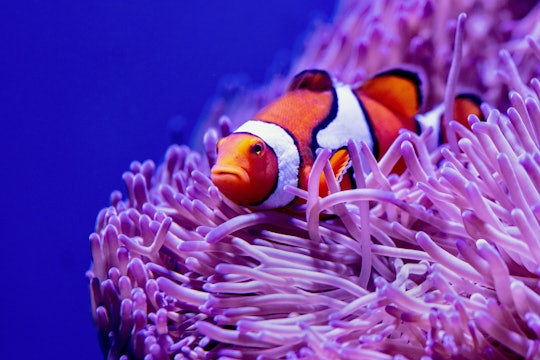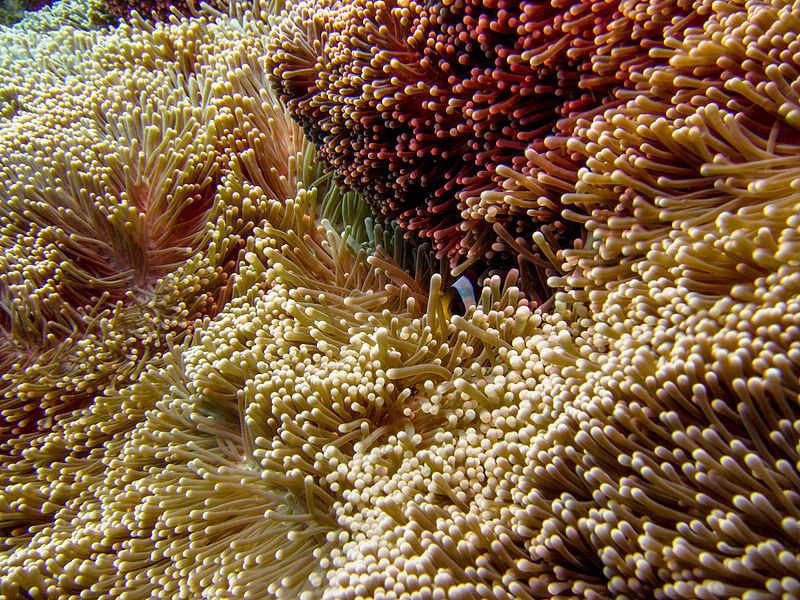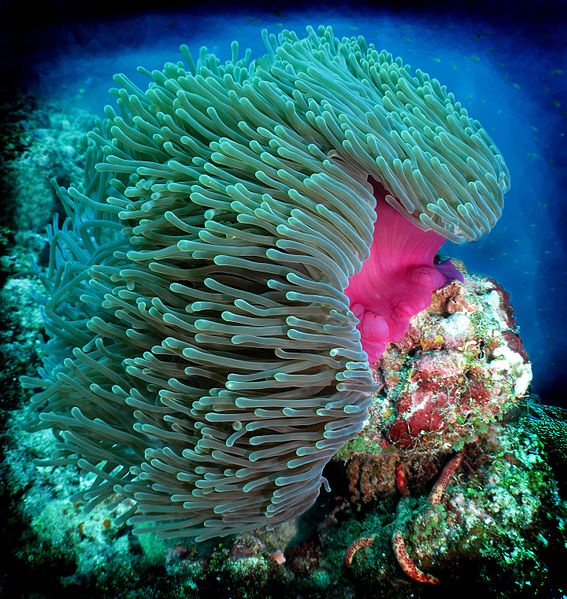
Photo by David Clode on Unsplash
Choosing which anemone species to call home has dramatic consequences for young clownfish
New research details why clownfish living in different types of anemones develop stripes at different times
Among the coral reefs of Kimbe Bay off the coast of Papua New Guinea lives a population of clownfish. These charismatic orange fish display brilliant white stripes and make their homes among the stinging tentacles of sea anemones. In these waters, clownfish are hosted by two different species of sea anemone, the giant carpet anemone and the magnificent sea anemone. A study recently published in the Proceedings of the National Academy of Sciences showed that, instead of being an innocuous choice, the anemone home a clownfish selects can shape the rest of its life, and even its very body.
The study began when a team of French researchers made an observation: clownfish hosted by the giant carpet anemone developed their white stripes much earlier in life than those living among the magnificent sea anemone. They knew from studies on zebrafish that stripes form during metamorphosis, the process by which a wide array of animal species from their immature to their adult form. In vertebrates — including fish — thyroid hormone (TH) is often a primary driver of metamorphosis.
In the lab, the researchers exposed immature clownfish to different concentrations of TH and discovered that the individuals who received the highest dose developed their stripes the quickest. In contrast, the control group, which was not exposed to TH, were the slowest to develop stripes. Based on these results, they predicted that clownfish hosted by the giant carpet anemone (the ones that form stripes earlier) would have higher levels of TH, which is exactly what they found.

A small clownfish hidden among the tentacles of a giant carpet anemone
Ryan McMinds on Wikimedia Commons (CC BY 2.0)
This result answered the question of what is happening at a physiological level, but the researchers wanted to go deeper. Clownfish physiology, like other animals, is driven by their genes, so they wanted to understand these fish at the genetic level.
The scientists sequenced the RNA of clownfish living in the two different anemone species. This approach sheds light on what is driving trait variation by allowing researchers to compare gene expression levels across clownfish living in one anemone species versus another. In other words, it was important to know not just which genes they had, but how they were using them.
The researchers found that out of the roughly 19,000 genes expressed in juvenile clownfish, only 36 were expressed differently between individuals hosted by one anemone species versus another. By far the most interesting of those 36 genes was a gene known as duox. This gene is known to play a key role in the production of thyroid hormone and studies in other fish have shown that lower levels of duox are associated with lower levels of TH. Clownfish living in the giant carpet anemone (those with higher TH and faster stripe formation) express duox at a much higher level than clownfish living with the magnificent sea anemone. Here was a potential genetic mechanism.

A vividly colored magnificent sea anemone
Neville Wootton on Wikimedia Commons (CC BY 2.0)
However, just because a gene has a known function in one organism does not necessarily mean it has the same function in another. One of the best ways to understand how a gene works is to use the genetic tool CRISPR, which allows researchers to delete genes in the embryo stage and then observe how this change affects the organism as it lives and grows. Unfortunately CRISPR is not always easy to use in every organism (a statement I, the author, can confirm from personal experience), so oftentimes the best workaround is to use it in a related model organism.
The research team collaborated with a group of colleagues at another university to delete the duox gene in zebrafish, a well-studied species that is both easy to manipulate with CRISPR and, importantly, also has stripes. Zebrafish without the gene developed a single broad stripe instead of their typical four thin ones. Because of their status as a model organism, much is known about the way zebrafish stripes develop, so the researchers were able to conclude that the presence of a single broad stripe meant that duox affects the timing of stripe formation.
The researchers were not shy about the fact that this study leaves two major questions unanswered. First, why is duox expressed at a higher level in giant carpet anemone dwellers and second, is there an ecological consequence of faster stripe formation?
Little is known about the evolutionary significance and function of body coloration in clownfish, but there are two leading hypotheses. The first is that it allows different species to recognize each other. Clownfish are highly social and often there are multiple species living in the same area of a reef. As a result, being able to recognize other species as separate from your own is incredibly important for maintaining social order and species boundaries. The second hypothesis is that color patterns are a result of different clownfish species preferring to live with specific (and distinct) anemone species. Very little is known about how clownfish select their hosts or why there seem to be species-specific preferences, but investigating this process would certainly shed light on clownfish coloration. While neither hypothesis has an overabundance of evidence supporting it, we do know that there is a relationship between the color of a clownfish species and the toxicity of its anemone host. The more toxic the anemone, the less colorful the fish.
The true function of white stripes remains unclear, but the study discussed here certainly adds a finger to the scale by showing physiological and genetic consequences of the relationship between clownfish and their anemone hosts. There is still much to learn about this system, but the more we discover, the more tangled the web of ecological interactions grows. So much appears to rest on one of the earliest decisions a young clownfish makes: Which tentacles do I call home?
